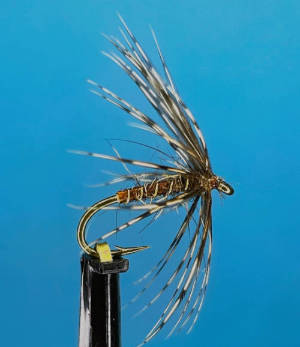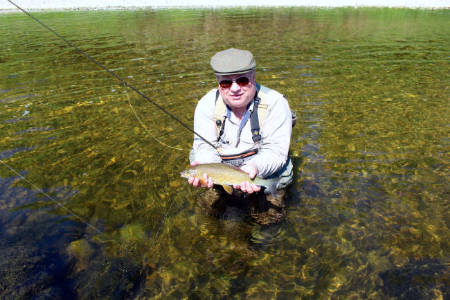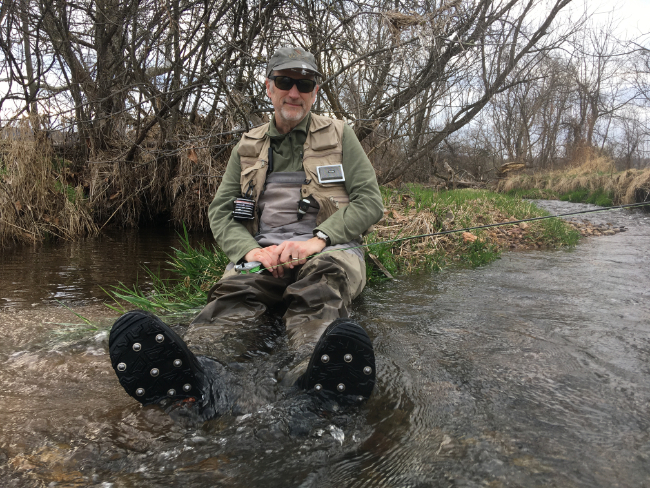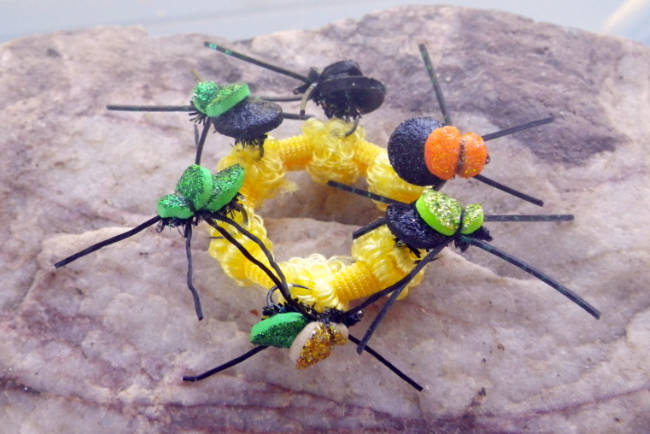


|

|
www.cjtu.org |
September 2023 |
General MeetingTuesday, September 12, 2023
Note: Around 7:30 pm John will do a hands-on tying session, demonstrating the steps of dressing basic Spider flies.Get to the hall early if you want to atend this session!
John Shaner’s presentation will cover the history and development of Spiders and Soft Hackle flies on both sides of the Atlantic, as well as their materials, tying, and fishing techniques. Around 7:30 pm John will do a hands-on tying session, demonstrating the steps of dressing basic Spider flies . He will cover simple thread bodied and dubbed Spiders. John grew up in a fishing family on the shores of Skaneateles Lake in the Finger Lakes region of New York State, he has been an avid angler even as a youngster, and caught his first trout on a fly he tied himself in 1966. The gift of a fly-tying kit when he was eight set him on the road to becoming a fly tier. Although he is primarily self-taught, he has studied many different fly dressing techniques and has been privileged to have sat at the elbow of many famous fly tiers. While he dresses many different fly styles to suit the rivers he fishes, he especially enjoys reproducing and using traditional trout patterns. Catskill style dry flies were his first interest, but in the past 25 years his focus has been on British wet flies. John has developed a profound interest in “Spiders”, which Americans call them “Soft Hackles”, and he enjoys tying and fishing these simple, elegant, and deadly flies. While he likes to experiment with new patterns, he is a bit of a traditionalist in his use of materials and seldom incorporate synthetics into his flies, preferring to use natural silk, fur, and feathers. 
Another of John’s passions is collecting classic fly tackle and angling books. His interest in tackle reflects his pursuit of free-rising trout and a love for fishing both dry flies and wet flies near the surface. John’s angling library contains over 2000 books and publications dating back to the 18th century. The collection is primarily focused on works detailing the development of trout flies and tying techniques but branches into many other aspects of fly fishing as well, especially the history of the sport and its literature. John began exploring the Catskills as soon as he had a driver’s license and in the years since he has fished for trout across the US from Maine to Oregon, Michigan to New Mexico, and he has made a number of trips to the UK to fish the famous Chalk Streams and other rivers. John has a special love for Montana and Wyoming, and lived in West Yellowstone, Montana during the 1990’s where he managed a fly shop and guided clients throughout the state and in Yellowstone National Park. His favorite rivers are the West Branch of the Delaware and the Beaverkill in New York State, the Firehole and Madison system in Yellowstone National Park, the spring creeks of Paradise Valley in Montana, and in England, the Itchen at Abbots Worthy in Hampshire, the Rivers Eamont and Eden in Cumbria, and the Wharfe in Yorkshire. He has also fished the Bahamas, Belize, and Florida for saltwater species. Most of his working career has been spent in the fly-fishing business where John has managed fly shops, guided, and worked as a sales representative for The Orvis Co. and Cortland Line. Since 2008 he has been associated with Hardy of Alnwick, England. John retired in 2021 to devote more time to fishing, travel, and his collections. John is a member of The Anglers’ Club of New York, The Fly Fishers’ Club of London, The Theodore Gordon Fly Fishers, The Fly Fishers’ Club of Harrisburg, Trout Unlimited, and the IFFF. He also serves as a Trustee of the Catskill Fly Fishing Center & Museum. He currently lives in Deposit, NY, just a stone’s throw from his favorite pool on the West Branch of the Delaware River and only a few minutes from the East Branch, Beaverkill, and Willowemoc. Tuesday, October 10, 2023

When angler and author Stephen Sautner bought a streamside cabin and some land on a tributary of the Upper Delaware River, he thought he had reached trout fishing Nirvana. Little did he know what was in store for him: a series of historic floods, a land rush over fracking for natural gas, and constant battles with invasive species and other invaders. Sautner will discuss these battles and how they helped him gain a better understanding of the interconnectedness of trout fishing with the natural world and what it means to be an angler in the 21st century. Sautner is the author of three books: “A Cast in the Woods,” “Fish on, Fish Off” and “Upriver and Downstream.” He was a regular contributor to The New York Times “Outdoors” column for more than a decade. His writing regularly appears in The FlyFish Journal, Angler’s Journal, The Drake, Fly Fishing International, and other publications. His recent essay in The Drake on the “slow fishing movement” has resonated with a anglers from all over the world. He has cast a line in more than a dozen countries most recently in the Panama Canal where he still doesn’t want to talk about the tarpon he lost. Locally, Sautner quietly fishes NJ bluelines. He also fly fishes for shad, casts plugs for stripers, and jigs panfish through the ice. You can learn more at www.stephensautner.com or follow him on Twitter: @FishOn_FishOff Meeting LocationAmerican Legion Hall
|
Fly of the MonthDouble Disc’O Beetle VariantTied by Bill Ninke
As did most other beginning fly fishers in the early 80s, I focused on mayfly and caddis patterns. But I eventually learned that beetles are effective in many situations, surprisingly even during mayfly and caddis hatches. I tied and fished the most common beetle of the day, the Crowe beetle. It’s a simple pattern, just peacock herl and deer hair. It did and still does produce well. But trout teeth quickly scuff it up. So I was on the lookout for a more durable alternative. Fast forward now to November 2003 when I attended the International Fly Tying Symposium. There I spent a long time at the demo bench of Harrison Steeves III. Harry was tying many of the terrestrial patterns that had just been published in his book, “Tying Flies with Foam, Fur, and Feathers”. One pattern that really impressed me was his Double Disc’O Beetle which is made from two discs of Loco Foam with added body and wing material. I thought it would be the durable beetle I was seeking. So I bought some Loco Foam, Kreinik micro ice chenille, Kreinik tyers ribbon, and a set of hollow punches from Harry and went home to duplicate his pattern. The hollow punches are used to create the foam discs. If you are going to tie this month’s fly and some future patterns I’ll be presenting, you’ll need a set yourself. I don’t recall what I paid back then but the requisite set of six is currently available from Harbor Freight for $10. If you are not familiar with Loco Foam, it is a 2 mm thick foam sheet with a colored metallic coating on one side. The metallic coating gives terrestrial patterns created from it a “shiny glint” characteristic of real insects. Once home I tied a batch of beetles as best I remembered Harry’s demo and, over the following season, gave them a try. They worked great and indeed were very durable. They became a staple in my fly box. Over the next dozen years I continually replaced those lost to trees, snags and an occasional break off. This used up my initial supply of Loco Foam and Tyers Ribbon. When I sought more foam I found it had gone out of production. So I searched for and found an alternative, an inexpensive craft store product called Glitter Foam. This is a 2 mm thick foam sheet with shiny particles embedded in one surface. It comes in many colors, and is available in both plain back and adhesive backed versions. The pattern I am about to detail uses the adhesive backed version since the “in place” adhesive eliminates the need for super glue as required in the original Steeves version. Loco Foam has recently come back on the market but I’m sticking with the glitter foam. When I had run out of the Tyers Ribbon, I eliminated the wings made of the ribbon and added silicone strand legs. This variant seemed just as effective and is faster and easier to tie. You can also use small round rubber legs. I have experimented with different sizes and styles of hooks on which to tie this beetle but have settled on a wide gap dry fly hook. This style hook gives good keeling so the beetle quickly turns upright once it hits the water and hold large fish well. I tie mostly and give instructions for a size 14 beetle. Other sizes can of course be tied. My specified foam disc diameters will have to be adjusted if you so choose. Once you’ve punched out the foam discs, tying is simple and fast as you’ll see from the sparse instructions. The photo shows options for color combinations that I most frequently use. The all black is very effective but hard to see so I usually fish it as the point fly in a two fly rig with one of the “bright top” combinations as the dropper. When fishing this beetle, splat it down hard on the water. This gives the sonic signature of a fallen real beetle. Fish often come from afar to check what just hit the surface. Click here for the recipe! |
Central Jersey Trout Unlimited’s Supporters |